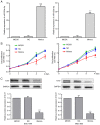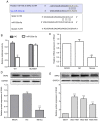Upregulation of microRNA-520a-3p inhibits the proliferation, migration and invasion via spindle and kinetochore associated 2 in gastric cancer
- PMID: 31452811
- PMCID: PMC6704319
- DOI: 10.3892/ol.2019.10663
Upregulation of microRNA-520a-3p inhibits the proliferation, migration and invasion via spindle and kinetochore associated 2 in gastric cancer
Abstract
MicroRNAs (miR) serve important roles in the development and progression of tumors by targeting different genes. miR-520a-3p reported in lung and breast cancers as a tumor suppressor gene. However, the expression and functional significance of miR-520a-3p is not completely understood in gastric cancer (GC). In the present study, it was demonstrated that the expression levels of miR-520a-3p were significantly downregulated in GC tissues and cells using RT-qPCR. In addition, downregulated expression of miR-520a-3p was associated with the clinical stage of the tumor and invasion in patients with GC. Furthermore, overexpression of miR-520a-3p significantly inhibited cell proliferation, invasion and migration in SGC-7901 and MGC-803 GC cell lines using proliferation, wound healing and cell invasion assays. Spindle and kinetochore associated 2 (SKA2) was upregulated in GC cells using western blot analysis and a target gene of miR-520a-3p; miR-520a-3p mimics significantly reduced SKA2 expression. In addition, upregulation of SKA2 protein expression SKA2 reversed the miR-520a-3p-mediated inhibition of SGC-7901 cell proliferation, migration and invasion. In conclusion, miR-520a-3p functioned as a tumor suppressor gene by targeting SKA2 in GC cell lines, and may serve as a novel prognostic and potential therapeutic marker.
Keywords: gastric cancer; invasion; microRNA-520a-3p; migration; proliferation; spindle and kinetochore-associated protein 2.
Figures





References
-
- Global Burden of Disease Cancer Collaboration. Fitzmaurice C, Allen C, Barber RM, Barregard L, Bhutta ZA, Brenner H, Dicker DJ, Chimed-Orchir O, Dandona R, et al. Global, regional and national cancer incidence, mortality, years of life lost, years lived with disability, and disability-adjusted life-years for 32 cancer groups, 1990 to 2015: A systematic analysis for the global burden of disease study. JAMA Oncol. 2017;3:524–548. doi: 10.1001/jamaoncol.2016.5688. - DOI - PMC - PubMed
LinkOut - more resources
Full Text Sources
Miscellaneous
